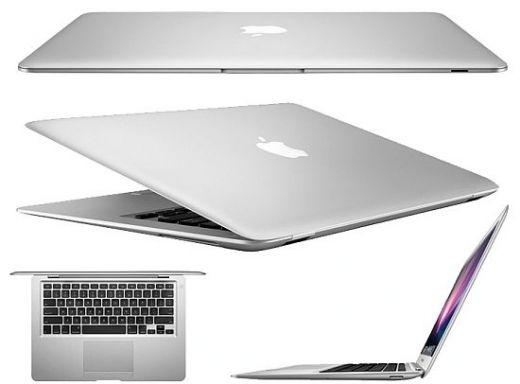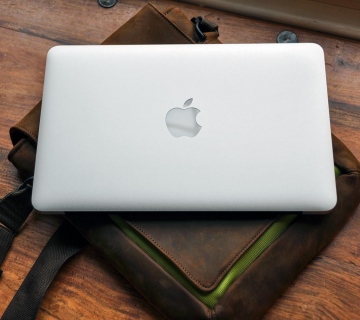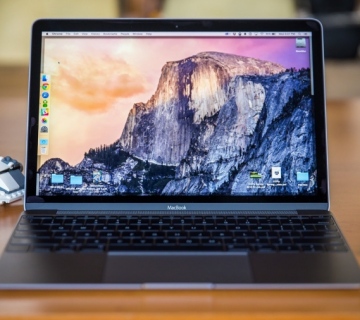Early in 2008, the first generation of the MacBook Air on the market. It was light and thin, but not particularly fast, and cost also far more than most were willing to spend on a laptop. Get contacts and the lack of optical drive also had many shaking their heads at Apple’s antics.
But the focus on this relatively narrow segment of the market meant that Apple had good training in how to build laptop of this type. Two years ago, a completely redesigned model, and the prices were adjusted. People were far more interested, the competition opened his eyes and Intel kicked off the investment in so-called ultra book.

The result of this we have seen a couple of good examples of earlier this summer. With Samsung’s 9-series and Asus’ Zenbook we have seen that a laptop did not need to have an apple on the lid to be thin, light and delicious.
But anyway, back to the MacBook Air – Apple’s thinnest laptop. It comes in two sizes, as of 11.6 and 13.3 inches. Although this particular test is of 13-inch, remember that most of the points will also apply to his brother. Specifications
Hardware
Processor Intel Core i5-3427U (1.8GHz, 3MB cache)
Memory 4 GB DDR3 1600 MHz RAM
Hard drive 128 GB SSD
Graphics Intel HD Graphics 4000
Display 13.3-inch
1440 x 900 pixel resolution
Reflective contrast coating
Optical unit N / A
Wireless 802.11a/b/g/n Wi-Fi
Bluetooth
Battery 50 Wh, 7 hour battery life quoted
Other
Operating System OS X Mountain Lion (tested with Lion)
Size 1.7 cm thick
Computer Weight: 1.35 kg
Power supply: 200 grams
Apple MacBook Air 13 “can also be configured with a 2.0 GHz Core i7 processor, 8 GB memory and up to 512 GB SSD. Outside, there has not been anything special compared to its predecessor – it’s on the inside that the changes have taken place. Most important is the transition to Intel’s “Ivy Bridge” processor generation and associated integrated graphics solution – which we include also find on the competing models from Asus and Samsung. Good news is that USB 3.0 is finally in place for Apple’s portable.
In use
As we have mentioned, there are no major physical changes from the next generation MacBook Air. The only difference we have been able to find is that the magnetic type 2 MagSafe This connector is slightly thinner and slightly longer than the standard MagSafe. If you use your old power supply, you do as a transition to 89 million.
Apart from this detail has thus not happened with the MacBook Air’s appearance in two years – the construction is good, with well-known forms in the same familiar gray aluminum. Now, then this naturally enough, a matter of taste, but we think that the change rejoice – there’s a reason why car models get a facelift, or so-called “facelift” approximately every two years. MacBook Air might also have benefited from a little refresher in style.
Keyboard and Touchpad
There is also that we have become accustomed to. The large touch pad of glass is sensitive and supports moves by up to four fingers simultaneously. The backlit keyboard is regulated by a sensor, but can also be set manually. The square keys make relatively little noise, and the keyboard itself is quite nice to write on. Keyboard layout is typically on a Mac, but note that our test sample came with an international keyboard. Norwegian keyboard layout is slightly different.
Screen
Apple is one of fewer and fewer manufacturers who offer displays in 16:10 format. For 13.3-inch, the resolution at decent 1440 x 900 pixels, compared to the typical 1366 x 768 with such small screens. But even if Apple were here early on a higher resolution than usual, they have now been overtaken by competitors. Samsung 9-series has a PLC panel, which is a type of IPS technology with a resolution of 1600 x 900 pixels. Owners of an Asus Zenbook Prime boast Full HD on its IPS screen that is the 1920 x 1080 pixels.
The glossy screen on the MacBook Air has good brightness, although it is far too close to best in class. Colors and contrast are quite good, and the viewing angle is better than the cheapest laptop. But we are obviously not unaffected by testing these models from Asus and Samsung. Apple’s own MacBook Pro Retina display has of course made an impression. So yes, the screen is good, but we also know that there are better options out there.
Speakers
The built-in speakers deliver sound with decent dispersion and stereo effect. Votes and treble are well forward. Bass is natural enough in short supply – this is typical for thin notebooks this size. All in all, the machine from the kind of problem sounds a little video or background music, but it is not necessarily a real feel of it.
Connections Inputs and outputs
Type and interface
Image Thunderbolt (Mini DisplayPort)
Audio 3.5mm mini jack
Device Connection 2 x USB 3.0
Network 10/100 Ethernet over USB or Gigabit Ethernet over Thunderbolt
Other Integrated webcam and microphone
Memory Card Reader for SD
Just like the MacBook Pro Retina display, it’s not exactly full of contacts on the MacBook Air. And if you desperately need to burn a DVD, or connect to a network with a cable, you must focus on external Thunderbolt or USB devices that help you with this.
On the left we find a USB 3.0 connector, mini jack for audio and the opening of the built-in microphone. At the back is the new contact for power consumption: MagSafe 2
On the right is probably a USB 3.0 connector, plus the Thunderbolt port and reads SD memory card.
Temperature and noise
Apple’s own OS X is an energy-efficient operating system, and it is also reflected in the temperatures. Idle or light load, the MacBook Air among the coolest laptops we’ve seen. It is also very quiet – the fan is indeed continuous, but can hardly be heard unless you put your ear up.
As you can see it also keeps the heat in check by heavy traffic, even though both Asus’ Zenbook Prime and Samsung 9 series does a better job. But this does not come without a price that you then have to pay in the form of a very angry fan noise.
Battery
We are currently testing the battery life by playing HD movie clips (720p) in VLC media player and see how long your computer is doing on battery power. Since VLC is available for all platforms, we have done this on Apple’s operating system as well. In this test failed MacBook Air a little over five hours of power from the battery. It makes the words a little better than the Samsung 9-series, while it hangs a bit after Asus Zenbook Prime.
We let the machine stand idle as long as it did, and when we ended up in nine hours from a fully charged battery. Apple even provides battery life to seven hours for a 13-inch MacBook Pro.
Performance
MacBook Air is of course Apple’s own operating system, OS X Mountain Lion. Our test sample ran the older version, “just” Lion. We also tested the machine with Windows 7 Home Premium. All Macs come with a tool called Boot Camp, which makes such an installation to a relatively simple affair.
System Performance
In this test we have set the MacBook Air 13 “up against two other very current 13.3-inch Asus Zenbook Prime UX31A and Samsung’s new 9-series. Both are running Intel’s new Ivy Bridge platform and costs about the same as the current test copy that is about ten thousand dollars.
All three computers have power-efficient ULV processors. MacBook Air features an Intel Core i5 with 1.8 GHz clock frequency, while Sam’s kid has his little brother at 1.7 GHz. Zenbook Prime UX31A have an i7 processor at 1.9 GHz clock frequency, and should then theoretically be the fastest machine of the three.
Zenbook and MacBook Air will on paper have the same graphics performance, but the Windows Experience Index tells us that the MacBook Air is a bit faster.
In Cinebench 11.5 is pure processing power to render an image – first with a processor core (and a process thread), then with all it has the muscle. Here is the results related pattern, with Prime Zenbook front of the MacBook Air. Also in the video converter HandBrake we get the same result, which Asus UX31A makes it a bit better than the Apple machine.
We recall that by the way, if you need a laptop for heavy computing, a thoroughbred MacBook Pro or equivalent PC will do the job much faster. For lighter tasks, or heavy work only over short intervals, not the difference in performance is as evident.
Play Performance
For gaming tests we used the Windows 7 operating system on your MacBook. The exception is the OpenGL test, which was run in OS X Lion. The results are consistent if nothing else – MacBook Air is the machine that makes the best here. But of course we should not forget that this is the small margins – both in terms of system performance and graphics performance. Unless you test with particularly demanding applications, as we do here, you will probably not notice any practical difference. If you have to wait for 20 or 21 minutes for the video to be converted, or if you get 57 or 65 FPS (frames per second) in a game, will have no significant impact for most of us.



